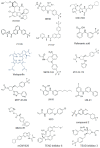Hippo Signaling at the Hallmarks of Cancer and Drug Resistance
- PMID: 38607003
- PMCID: PMC11011035
- DOI: 10.3390/cells13070564
Hippo Signaling at the Hallmarks of Cancer and Drug Resistance
Abstract
Originally identified in Drosophila melanogaster in 1995, the Hippo signaling pathway plays a pivotal role in organ size control and tumor suppression by inhibiting proliferation and promoting apoptosis. Large tumor suppressors 1 and 2 (LATS1/2) directly phosphorylate the Yki orthologs YAP (yes-associated protein) and its paralog TAZ (also known as WW domain-containing transcription regulator 1 [WWTR1]), thereby inhibiting their nuclear localization and pairing with transcriptional coactivators TEAD1-4. Earnest efforts from many research laboratories have established the role of mis-regulated Hippo signaling in tumorigenesis, epithelial mesenchymal transition (EMT), oncogenic stemness, and, more recently, development of drug resistances. Hippo signaling components at the heart of oncogenic adaptations fuel the development of drug resistance in many cancers for targeted therapies including KRAS and EGFR mutants. The first U.S. food and drug administration (US FDA) approval of the imatinib tyrosine kinase inhibitor in 2001 paved the way for nearly 100 small-molecule anti-cancer drugs approved by the US FDA and the national medical products administration (NMPA). However, the low response rate and development of drug resistance have posed a major hurdle to improving the progression-free survival (PFS) and overall survival (OS) of cancer patients. Accumulating evidence has enabled scientists and clinicians to strategize the therapeutic approaches of targeting cancer cells and to navigate the development of drug resistance through the continuous monitoring of tumor evolution and oncogenic adaptations. In this review, we highlight the emerging aspects of Hippo signaling in cross-talk with other oncogenic drivers and how this information can be translated into combination therapy to target a broad range of aggressive tumors and the development of drug resistance.
Keywords: EGFR; KRAS; cancer; carcinogenesis; combination therapy; drug resistance; hippo signaling.
Conflict of interest statement
The authors declare no conflicts of interest.
Figures



Similar articles
-
Hippo pathway effectors YAP, TAZ and TEAD are associated with EMT master regulators ZEB, Snail and with aggressive phenotype in phyllodes breast tumors.Pathol Res Pract. 2024 Oct;262:155551. doi: 10.1016/j.prp.2024.155551. Epub 2024 Aug 15. Pathol Res Pract. 2024. PMID: 39153238
-
Transcriptional output of the Salvador/warts/hippo pathway is controlled in distinct fashions in Drosophila melanogaster and mammalian cell lines.Cancer Res. 2009 Aug 1;69(15):6033-41. doi: 10.1158/0008-5472.CAN-08-4592. Epub 2009 Jul 7. Cancer Res. 2009. PMID: 19584286
-
The Hippo pathway integrates PI3K-Akt signals with mechanical and polarity cues to control tissue growth.PLoS Biol. 2019 Oct 15;17(10):e3000509. doi: 10.1371/journal.pbio.3000509. eCollection 2019 Oct. PLoS Biol. 2019. PMID: 31613895 Free PMC article.
-
Multifaceted regulation and functions of YAP/TAZ in tumors (Review).Oncol Rep. 2018 Jul;40(1):16-28. doi: 10.3892/or.2018.6423. Epub 2018 May 8. Oncol Rep. 2018. PMID: 29749524 Free PMC article. Review.
-
Hippo Signaling in the Liver Regulates Organ Size, Cell Fate, and Carcinogenesis.Gastroenterology. 2017 Feb;152(3):533-545. doi: 10.1053/j.gastro.2016.10.047. Epub 2016 Dec 19. Gastroenterology. 2017. PMID: 28003097 Free PMC article. Review.
Cited by
-
Aggressive high-grade NF2 mutant meningiomas downregulate oncogenic YAP signaling via the upregulation of VGLL4 and FAT3/4.Neurooncol Adv. 2024 Aug 24;6(1):vdae148. doi: 10.1093/noajnl/vdae148. eCollection 2024 Jan-Dec. Neurooncol Adv. 2024. PMID: 39380691 Free PMC article.
-
Multi-omics profiling of metastatic colorectal cancer reveals the transcriptional network of focal adhesion and immune suppression and the role of p-RPS6.Cancer Cell Int. 2025 Aug 7;25(1):300. doi: 10.1186/s12935-025-03924-6. Cancer Cell Int. 2025. PMID: 40770803 Free PMC article.
-
In vitro and In vivo Drug Metabolism Analysis of BPI-460372 - A Covalent TEAD1/3/4 Inhibitor.Curr Drug Metab. 2025 Feb 11;25(10):754-68. doi: 10.2174/0113892002351556250123105344. Online ahead of print. Curr Drug Metab. 2025. PMID: 39950481 Free PMC article.
-
Gastric Adenocarcinomas with CDX2 Induction Show Higher Frequency of TP53 and KMT2B Mutations and MYC Amplifications but Similar Survival Compared with Cancers with No CDX2 Induction.J Clin Med. 2024 Dec 15;13(24):7635. doi: 10.3390/jcm13247635. J Clin Med. 2024. PMID: 39768557 Free PMC article.
-
Aggressive high-grade NF2 mutant meningiomas downregulate oncogenic YAP signaling via the upregulation of VGLL4 and FAT3/4.bioRxiv [Preprint]. 2024 May 30:2024.05.30.596719. doi: 10.1101/2024.05.30.596719. bioRxiv. 2024. Update in: Neurooncol Adv. 2024 Aug 24;6(1):vdae148. doi: 10.1093/noajnl/vdae148. PMID: 38854109 Free PMC article. Updated. Preprint.
References
Publication types
MeSH terms
Substances
Grants and funding
LinkOut - more resources
Full Text Sources
Medical
Research Materials
Miscellaneous

